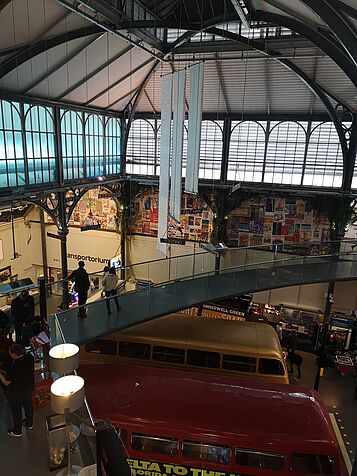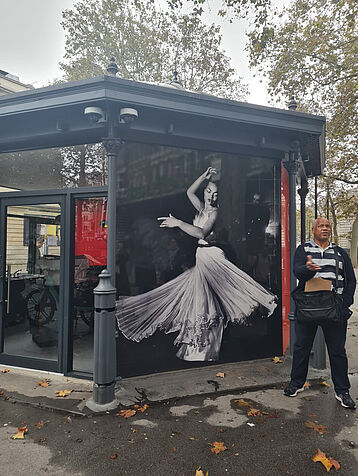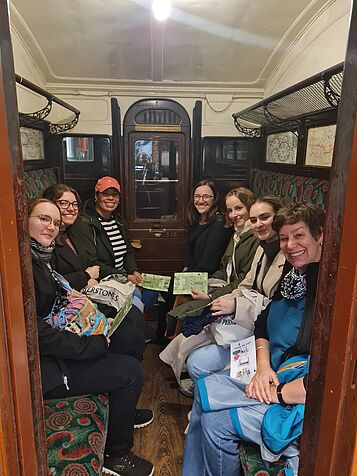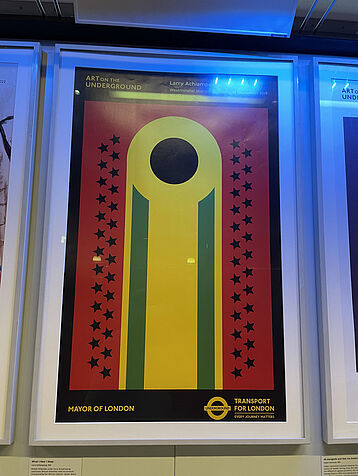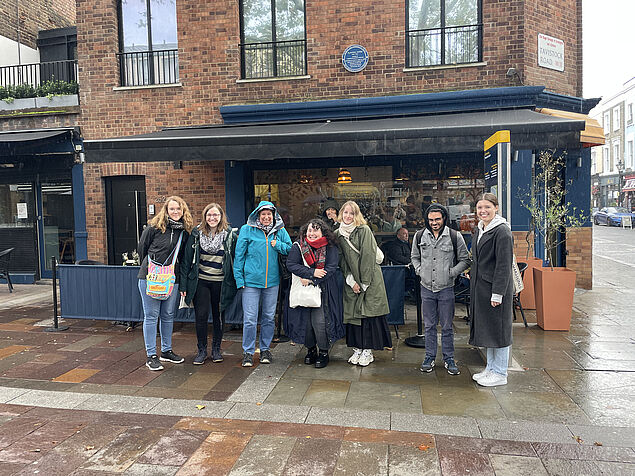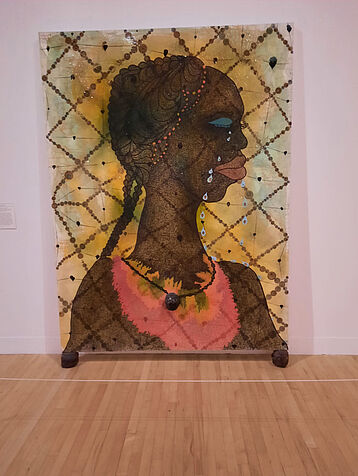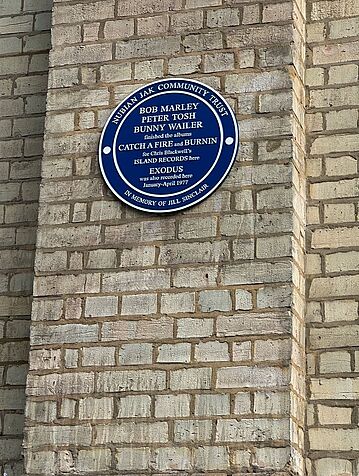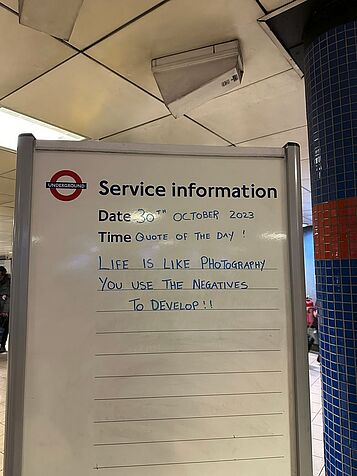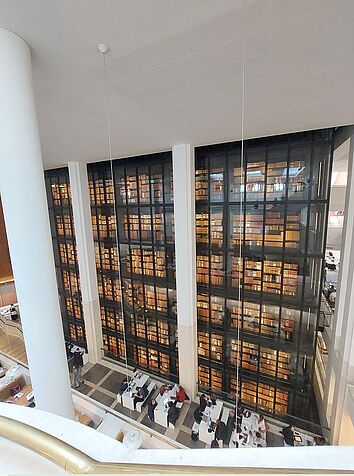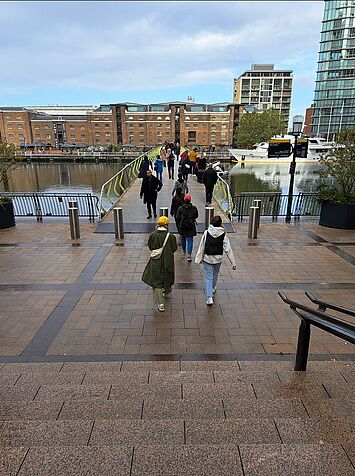Caribbean London Excursion (27-31 October 2023)
What do we do with time
and what time does with us
is the way of history,
spun down around our feet.
So we say, today,
that we meet our Caribbean shadow
just as it follows the sun,
away in the curve of tomorrow.
In fact, our sickle of islands
and continental strips are mainlands
of time with our own marks on them,
yesterday, today and tomorrow.
Andrew Salkey - History and Away
from Poems on the Underground: Black History Month (2023)
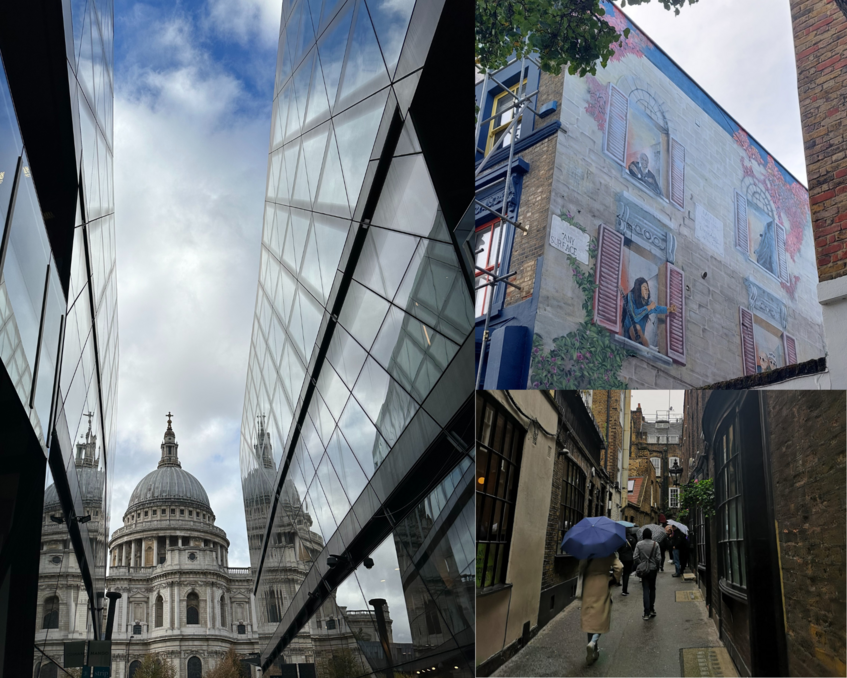
St. Paul's Cathedral, Mural in Notting Hill and Alley in Trafalgar Square - pictures by Marietta Pötz, Selina Rebhandl and Alina Hren
At the end of October, in the context of Prof. Sylvia Mieskowski's seminar on Caribbean Londoners, a 4-day programme took students on a Caribbean-themed trip to the British capital. Visiting numerous museums and exhibitions relating to Caribbean history and experiences in London, students had the opportunity to participate in walking tours and other activities relating to Black-British history and current Black-British experiences. The whole matter was financed largely by money granted by the University of Vienna when Prof. Mieszkowski was appointed Professor for British Literature at the Department of English Studies in 2017.
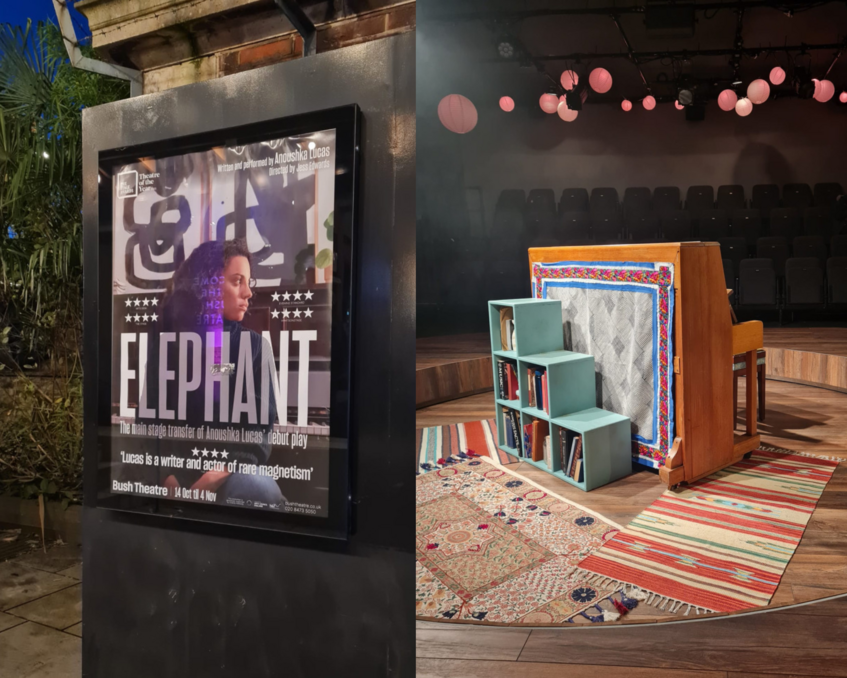
"Elephant" poster outside the venue and the moving stage of the Bush Theatre - pictures by Gizem Doğrul
Our London trip started on Friday evening with a performance at the Bush Theatre. The theatre is located in west London and its goal is to nurture, produce and uplift new playwrights and talents from a wide range of backgrounds and perspectives, reflecting the character of contemporary Britain. In this context, Anoushka Lucas, a singer, songwriter, actor and writer, was commissioned by the Bush to develop a play expanding on a song she wrote as a response to the killing of George Floyd.
"There are 88 keys on a piano. 52 of the keys are white, 36 of the keys are black. The white keys are called tones. And the black keys are called semi-tones. Which means half tone. So the black keys are like half of a white key." (Lucas, theatre programme Elephant 2023, 3)
Anoushka Lucas starts her debut play, Elephant, a one-woman performance, with these lines. The whole performance centres around a piano on a moving stage and the protagonist, Lylah. Elephant is a journey through Lylah's personal life, switching from her childhood to her young adult years, showcasing the particularities of growing up mixed-raced and working class in England. It is also a journey through the history of the British Empire and its effects on present-day Britain. After the performance, audience members and students had the opportunity to talk briefly with Lucas about her impressive performance.

Black History Walk outside of the bar Tom Cribb and a plaque on the front of the bar dedicated to Bill Richmond - pictures by Lisa Aponte and Selina Zadina
Each of our mornings in London started with a walking tour hosted by Black History Walks in a specific area of London. Tony Warner set up Black History Walks in 2007, to deliver educational tours about Britain's Black history, which is all too often overlooked or actively hidden. Our first walk took us around the Elephant & Castle area. Warner, who also acted as our guide, started the tour, using the surroundings and community buildings to tell harrowing stories of police brutality, wrongful detentions and the ensuing protests. After decades of struggling against these ongoing abuses at the hands of London Police, reports and studies were conducted, showing just how endemic and far-reaching these abuses were. Lisa Aponte, one of the students on the excursion, writes: "Through our black history walks in the heart of London, the Windrush generation's stories walk with us forever, painting a vivid mural of Caribbean history and their legacy blooms like a Caribbean breeze into our shared tapestry of knowledge."
In addition to police violence and community harassment, the early 2000s also saw the development of Black political figures, celebrities, and artists who used their various platforms to shed a much-needed light on the problems that Black Londoners face, especially in the decades following the arrival of the Windrush. As this edifying walk came to its end, Tony showed students encouraging developments from the 2000s onward about the campaigns to ensure representation of the Black community within the police, and giving meaningful education about contributions the Black diasporic community has made to London. There is, indeed, much work to be done; but the struggle against the hostile environment continues.

Black History Walk close to the Imperial Museum and Black History Walk in Notting Hill - pictures by Gizem Doğrul and Selina Zadina
The 2nd and 3rd walks (in Notting Hill and the West End, London's theatre district) told a fascinating narrative about businesses, athletes, singers, and community efforts that were instrumental in both representing Black people on the stage and in art more generally, but also in re-shaping the experiences of Black people throughout London and England. Learning, for example, about the many ways in which Black immigrants provided aid to one another, whether financial or legal, underscored the emphasis on community that was so useful in a context of ongoing racism. Similarly, students learned about the underrepresentation of Black performers and their achievements - something that one can unfortunately notice in the names of pubs and various placards in the Theatre district - and from there we learned about the staunch push to commemorate this integral part of London's history.
Following an enriching morning with Tony and the Black History Walks (and a much-needed lunch break), the excursion group visited the Museum of London Docklands. The exhibits on display tell a long story about the horrors of the slave trade, and how that legacy lives on throughout the broader history of England's industrial development and Earth-spanning empire. Students gathered to hear a learned and provocative introduction into labour abuses, the effects of which still live on in existing economic policies and establishment power. Selina Zadina writes: "The exhibit dedicated to educating the public on Britain's history in the slave trade is a grim reminder of a past frequently denied, ignored and downplayed by those who historically profited off of this sinister time in history. This is merely one amongst many other reasons why I found the visit to the Museum of London Docklands to be an interesting and informative part of this excursion." Displays and tours such as this one, then, act as a corrective to this sometimes ignored or minimised historical crimes and abuses whose legacies linger on into the present.
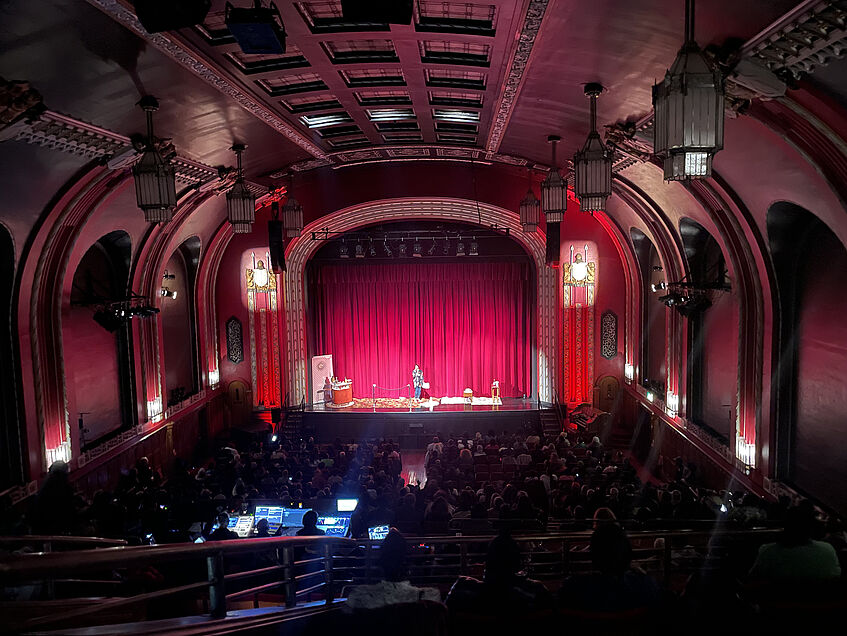
Inside the Broadway Theatre - picture by Katharina Wihan
The first full day ended at the Broadway Theatre with a showing of The Front Room, a Windrush Legend - a one-act play by Tony Fairweather, centred around the well-documented features of Caribbean Londoners' living spaces. The performance playfully referenced music, decorations, dances, sayings, rituals, mores, and meals that were recognizable to audiences growing up in the generations during and after the arrival of the Windrush. Alina Hren writes: "In the Broadway Theatre's play about the front room, it was not only the play itself or the wonderful stage design that made it an incredible experience; it was the audience. I felt immensely grateful to be able to sit amongst this crowd who remembered every piece of decor on stage and related to every joke, whether due to their own experience or that of their parents and grandparents. This play and its audience provided a glimpse into the Windrush generation‘s culture and community we otherwise never would have been able to have." The overall experience helped provide a humorous and familiar space where the backdrop of hostility and racism seemed to interweave the main text - mostly involving the visit of Aunty Viv and her family on a Sunday afternoon. At the same time, audiences laughing with recognition and finishing the performers' sentences made the evening a memorable experience for the younger generation and those who, like the students from Vienna, never had contact with such a deep and widespread cultural experience.
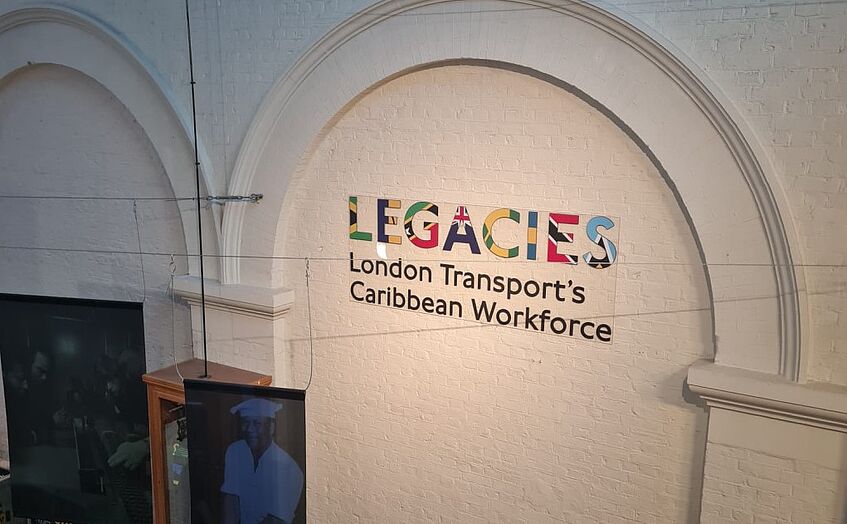
The London Transport Museum's exhibition on the Caribbean Workforce - picture by Gizem Doğrul
The history of the London transport network is easy to take for granted, especially given how often Londoners use it on a daily basis. But given the many years of innovations and planning involved, as well as the arduous forms of labour needed to build such an impressive system, the history is not only epic in scope, but it is central to understanding London as a whole. Katharina Wihan writes: "Exploring the London Transport Museum provided a fascinating journey through the city's transport history, where the intertwining narratives of black individuals within the system unfolded. It offered a new perspective, revealing the significant contributions and stories of diversity that have shaped London's intricate transportation network." Being able to go through this museum, and catching an installation about the labour supplied by those who arrived during the Windrush generation, students were able to witness not only how much this intricate system relied upon human ingenuity and strength, but also how it forever shaped the entirety of London society.
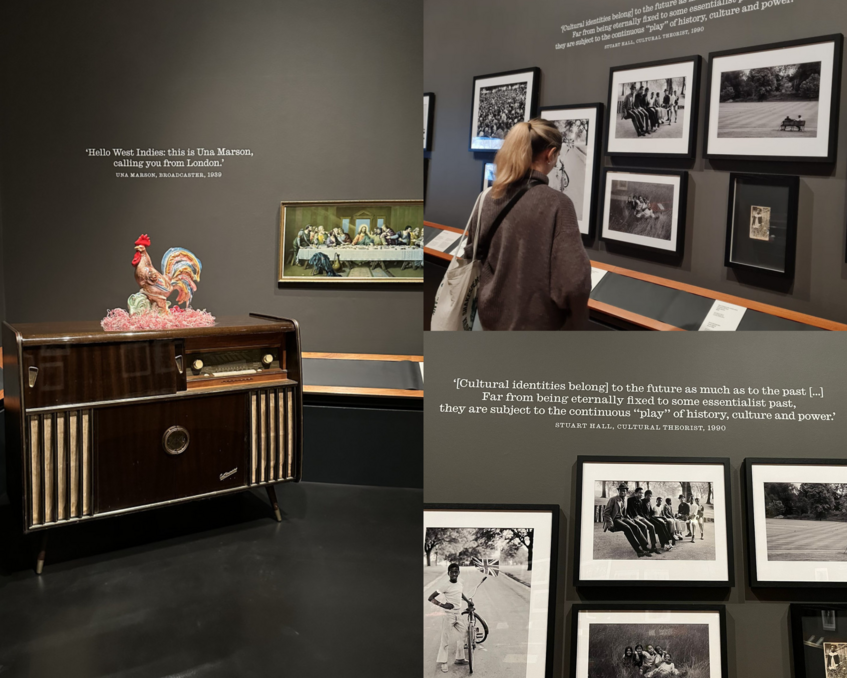
A porcelain rooster and stereogram, photographs of the Windrush Generation, and a quote by cultural theorists Stuart Hall - pictures by Marietta Pötz, Gizem Doğrul and Kevin Potter.
This day ended with a visit to the Victoria and Albert Museum in South Kensington. Besides housing millions of objects in its permanent collection, the V&A also displayed photographs and items related to the Windrush generation for its 75th anniversary. "Between Two Worlds" displayed numerous photographs, portraits and paintings from the Windrush generation created by two Jamaican scholars three centuries apart: Vanley Burke and Francis Williams. Additionally, items such as a stereogram and porcelain rooster were a nice addition to this part of the museum. Marietta Pötz writes: "'It was a chicken', 'No, my family had a glass fish', I overhear a conversation between two women as I stand in the V&A museum. They are talking about much more than a simple glass statue. It represents part of an identity, a decoratively placed ornament in the front room of their childhood homes that reminds many people of the struggles and the hopes their parents had for building a future in Britain. As part of the V&A focus on the Windrush generation, this exhibition on Diaspora Migrant Aesthetics in the Home brings all this alive. As I continue to walk through the museum, I am fascinated by the exhibits that give us a glimpse into the world of the Black community in the United Kingdom: one of Samuel Selvon's first editions of The Lonely Londoners, Harambee Organisation's Newsletter of Black Unity, or an analysis of the portrait of Jamaican scholar Francis Williams. With this, the V&A invites its visitors to the front room of a space that celebrates Black history and reminds us of the country's colonial past." The items and photographs we saw reminded us of the realities of the Windrush generation, their legacies and impact on the cultural landscape of Britain.
On our final day we visited the British Library, taking a good look at the treasures of the library. It was an incredible experience witnessing Shakespeare's First Folio, original and copy manuscripts of several writers (such as Charlotte Brontë), and the Magna Carta in their full glory.
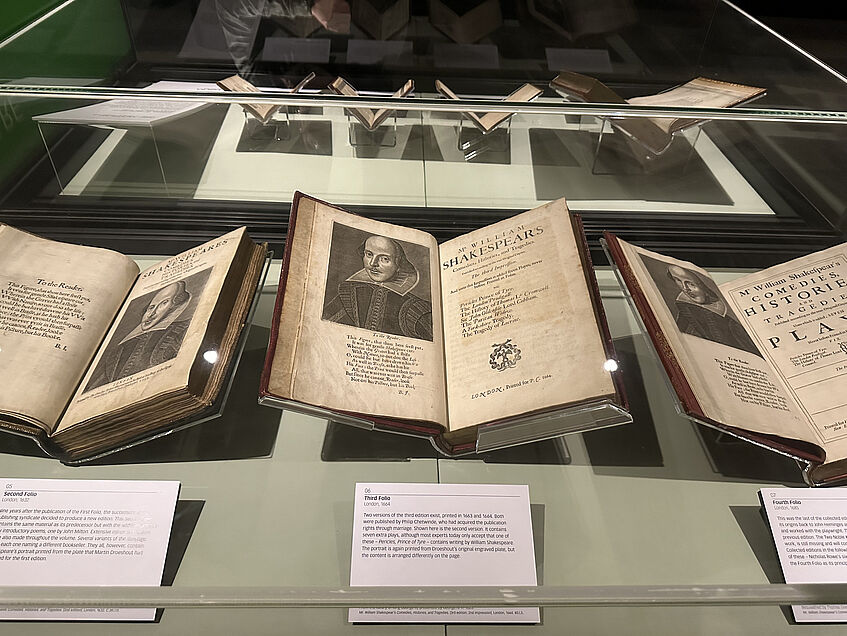
Shakespeare's Folios - picture by Marietta Pötz

"Keep Britain white" graffiti, photograph by Neil Kenlock MBE in the Tate Britain - picture by Lisa Aponte
Selina Rebhandl describes her impressions of the visit: "Visiting the British Library, getting to enter the mysterious world behind the counter, and being told about the library's history was fantastic. I was never more aware of my deep-rooted love for books than when walking through this building, and I was in awe and felt great privilege getting to see the library's treasures." During our guided tour of the British Library, students discovered a remarkable collection of literature and history, perfect for a large group of literature enthusiasts.
After our visit to the British Library, we enjoyed a tour of Caribbean-British artists in the Tate Britain. Visitors were enchanted by the sculptures of Rhea Dillon, which reflect on British and Caribbean identities, and being able to experience the works of other artists such as Donald Rodney and Chris Ofili. One particular piece of note was Chris Ofili's No Woman No Cry (1998), which incorporates images of Stephen Lawrence, who was murdered in 1993 in a racially motivated attack. These art pieces are quite impactful, and reinforcing the history of police brutality and institutional racism we learned during our Black History Walks. The interactive tour made it possible for visitors to voice their thoughts regarding these art pieces, making the experience extra special.
Some excursion participants were able to stick around after the Tate-visit and round off our time in London with a dinner at The Rum Kitchen in Brixton. Rum cocktails, jerk bowls, curried chickpeas served with rice, peas, and fried plantain with chilli jam brought to life the flavours of the Caribbean, before we set out to brave the rain on the autumn pavement one more time.

Dinner at The Rum Kitchen - picture by Alina Hren
by Gizem Doğrul and Kevin Potter

